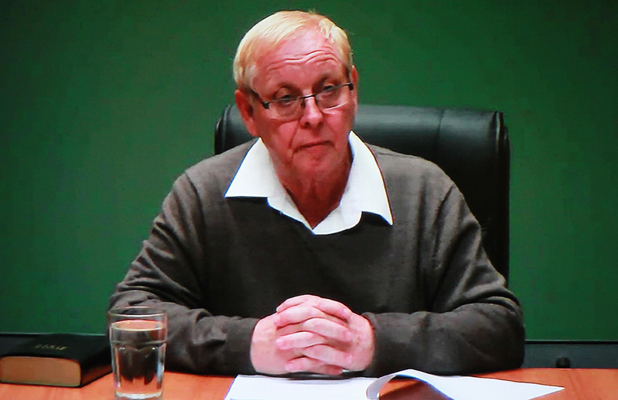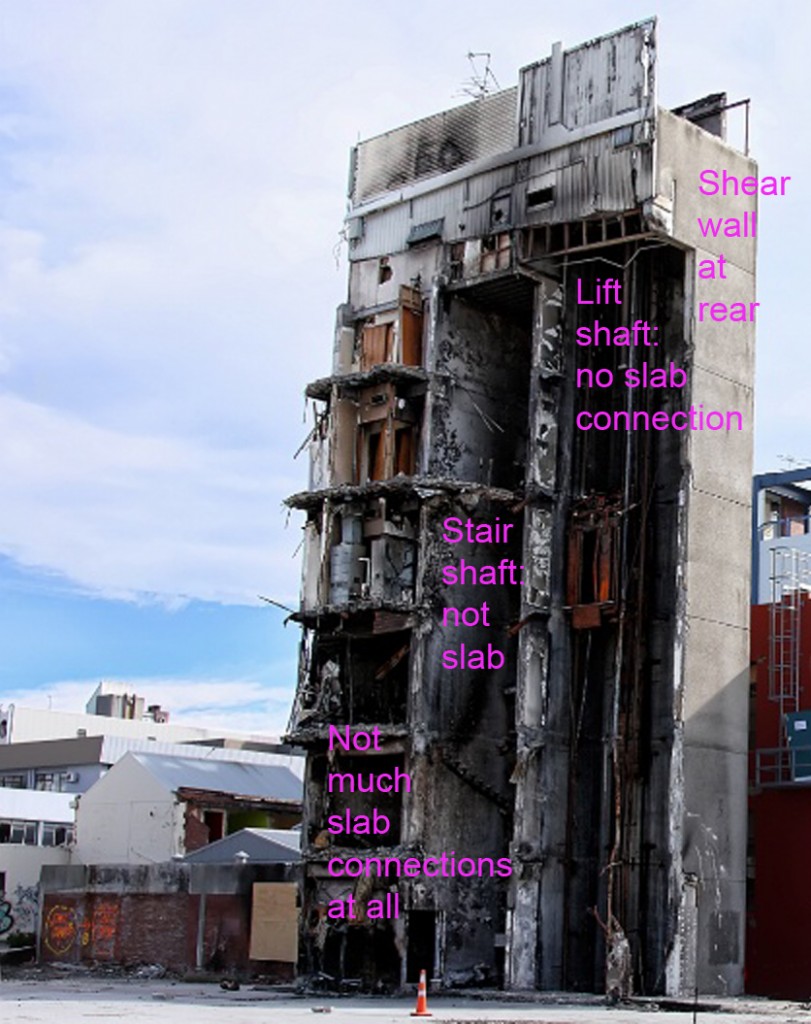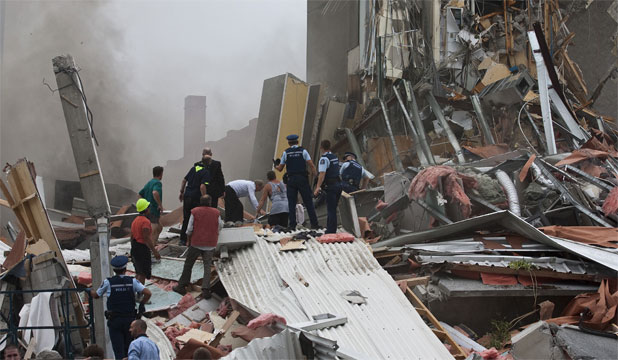There is a lot of interesting information coming out of Canterbury lately – not just the new City Plan, but also the videos at the enquiry into the collapse of the CTV building. In relation to what it is doing to Engineers, and other people involved in the building industry, it is almost more interesting than the Olympics on the other channel.

Almost.
Also, for almost the first time, an architect almost gave evidence: Alun Wilkie, the architect for the building that became known as the CTV building. By and large Wilkie denies any role in the structural design, which is what you would expect: architects, after all, tend not to be engineers as well on these bigger buildings. In fact, he was not there at the Commission at all, and someone else read his statement. The structural design role was left up to structural engineer Dr Alan Reay, who has now appeared three times. It’s fair to say that he got a real grilling from the lawyers at the Commission.

Also appearing, via video-link from Australia, was Gerald Shirtcliff – also known as Fisher. He also got a bit of a grilling as well. In fact, pretty much everyone seemed to be saying that they were not responsible for the CTV building. The architect says it was the engineer. The engineer says it wasn’t him, it was his employee. There’s no sign of the younger employee who may or may not have been responsible. The Council inspector is dead, but his wife says it wasn’t him. Others say that Alan Reay used to bully the Council inspectors, but Alan Reay says he had a good working relationship with the man from the council. Certain people on site say that the building was under the control of Shirtcliff, but Shirtcliff says he was hardly ever there, and can hardly remember going on site. It was 25 years ago, which is a long time, and I have no idea what I was doing on projects 25 years ago, but there are such clear differences of opinion that the only thing that is clear is that someone is lying. The question is: who?

I’m not feeling any pinch of schadenfreude about this. Nobody really expects to be grilled to the Nth degree, 25 years after a building project you worked on. Who can remember the text of a message to the Council or the reason for changing a detail on a revised drawing? Who wants to be held responsible for the mistake of the office junior who may or may not have been closely supervised in the office? Which office junior hasn’t goofed up at some stage and made a mistake that you have had to go to the boss and say “Sorry, I fucked up?” Those of you without sin, can throw the first stone.

The end result of any mistake will not, normally, ever be the cause of the death of 70 chinese language students in just a few seconds. The stakes are not normally that high. But mistakes can happen, and when the shit hits the fan, it goes everywhere, as we all know. All I can say is that if you have an inkling that something you may, or may not have done, may cause a problem later: Own up now, and get it fixed, sooner rather than later.

In the case of the CTV building, the Commission is still to finish hearing evidence and make its summary. What seems to be obvious however, is that the shear wall was built quite separately from the floor slab, and quite simply, the floors got shaken away from the core. There was nothing much holding the two parts together. In the case of a massive earthquake, far larger than code, it was doomed from the start.






No comment from you lot…. Hmmmm…. I have the suspicion that quite a few architects and engineers and city planning officials read this, and yet you do like to stay quiet. Our little web machine says that there are regular visitors from Athfields, from Jasmax, from the City Council, Studio Pacific, Beca etc. Feel free to comment you know, knock yourself out… Talk is good. Come on, let it all out. Speak to me baby…
Meanwhile, in an interesting development:
CTV design may have been beyond council
MARC GREENHILL
http://www.stuff.co.nz/national/christchurch-earthquake/7475718/CTV-design-may-have-been-beyond-council
“The Canterbury Television building’s “pioneering” design may have been beyond the expertise of council staff reviewing the plans, an inquiry has heard. John O’Loughlin, an experienced structural engineering peer-reviewer, today told the Canterbury earthquakes royal commission non-code compliance in the CTV building’s column should have been found by council’s reviewing engineers. However, the “pioneering” design would have made it difficult to pick up other some non-compliant elements.
“It would have stretched the capacity of the council staff to fully understand how that building was working,” he said.
It was unlikely Graeme Tapper, the council officer who approved the design, had colleagues with the necessary expertise to discuss the plans, O’Loughlin said.
“If that became an issue for a peer review in consulting office, there would be two, perhaps three engineers who would discuss it among themselves. [Tapper] didn’t have that advantage,” he said.
The commission has heard evidence that the building’s principal designer, David Harding, had limited experience with multi-level design and his employer, Alan Reay, did not check the plans. Counsel assisting the commission Stephen Mills asked O’Leary if, in his experience, it was appropriate that an engineer without experience in multi-level design be left to work unsupervised.
“No, it wouldn’t be appropriate,” O’Loughlin said.
The inquiry heard earlier suggestions the building may have been code-compliant were “opportunistic”. Douglas Latham, an engineer employed by building designer Alan Reay Consultants, said the building’s columns could be interpreted as code compliant using an “alternative set of assumptions”.
Panel member Barry Davidson, a structural engineer, said Latham was interpreting clauses in the code in a “very legalistic, opportunistic way”.
“It can’t be done that way and I think we should start just accepting that … You must understand engineering rules of nature,” he said.
Davidson had become “quite frustrated” with code interpretations and an inference that engineers of the time were less knowledgeable.
“It seemed to come from the legal professional that this is a legal document, and maybe it is, but it has to be interpreted by a competent engineer.”
Engineers in 1986 were “equally competent”, he said.
“I think the knowledge of behaviour of shear walls, etc, wouldn’t be far short of where it is today.”
Building codes would never be perfect, Davidson said. They would always require “good interpretation by knowledgeable people”.
“If we want to cherry-pick our way through it and find errors in this code, we’ll be going forever, and when we do it, we’ll still fall short,” Davidson said.
“I’m not too keen to support that this was an error in the code. I think it allowed ill-informed people to interpret it incorrectly.”
Panel member Arthur O’Leary said blaming errors in the code was “seeing things in a very black and white way”.
It seems that at least one person out there agrees with me:
http://www.stuff.co.nz/national/christchurch-earthquake/7505874/CTV-building-should-never-have-gone-up-says-husband
“The collapsed Canterbury Television building was “doomed from the start”, a victim’s widower says.
“If half those [errors] happened to any other building, people need to know. It’s scary in a way.”
The hearing was “quite helpful” and presented evidence that “made you sit up and take notice”.
“I’m sure a lot the families who attended thought it was going to be pretty dry, but it was totally different,” Kennedy said.
“So many errors, discrepancies, innuendo and possible lies have emerged that I found it hard to believe that all of this could happen to one building over such a short period.”
Some witnesses “lacked sincerity”, he said.